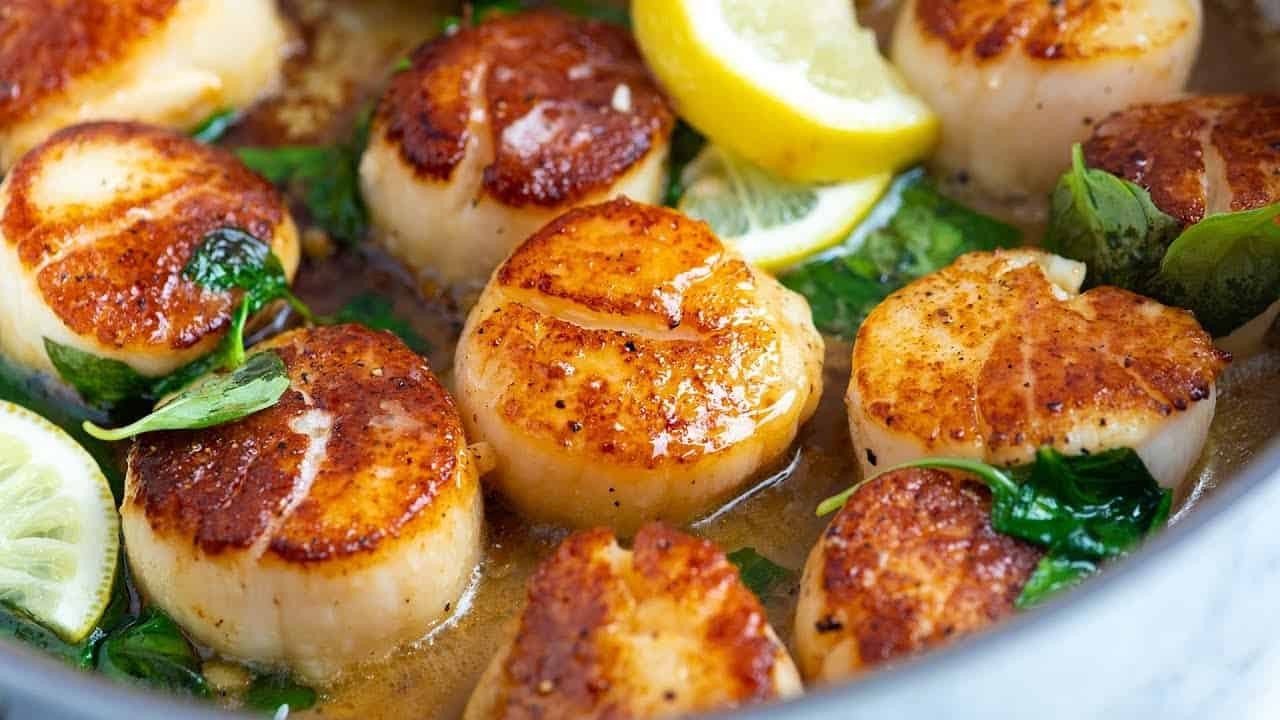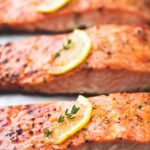Scallops are a delightful seafood delicacy that can elevate any home-cooked meal. Often seen as intimidating to prepare, cooking scallops at home is surprisingly simple and quick, especially when pan-seared. This guide will show you exactly How To Cook Scallops to achieve restaurant-quality results in under 10 minutes. We’ll cover everything from prepping your scallops to creating a luscious garlic basil butter sauce that perfectly complements their sweet, delicate flavor. Get ready to impress yourself and your guests with perfectly seared scallops!
If you’re familiar with cooking shrimp, you’ll find scallops just as easy, if not easier, to master. The key to incredibly delicious pan-seared scallops lies in a few simple techniques that we’re excited to share with you. Forget any hesitation – with our step-by-step instructions and expert tips, you’ll be cooking scallops like a seasoned chef in no time. And to make them truly irresistible, we’ll guide you through crafting a fragrant garlic basil butter sauce that takes these seared scallops to the next level.
Essential Ingredients for Pan-Seared Scallops
To make these sensational seared scallops, you’ll only need a handful of high-quality ingredients:
- Sea Scallops: Opt for large sea scallops for their naturally sweet taste and meaty texture. Fresh scallops are ideal, but frozen scallops work wonderfully too. If using frozen, see our thawing tips below to ensure they are perfectly prepped.
- Cooking Oil: Choose a high-heat cooking oil like avocado oil or vegetable oil. These oils can withstand the high temperatures needed for searing and contribute to a beautiful golden-brown crust.
- Salt and Pepper: Simple seasoning is key to highlighting the natural flavor of scallops. Use a generous amount of salt and freshly ground black pepper to enhance their taste.
- All-Purpose Flour (Optional): A light dusting of flour before searing is our secret weapon for achieving a deeply golden crust. The flour helps absorb excess moisture, promoting browning and creating a delightful texture. If you are gluten-free or prefer to skip flour, it’s perfectly fine, just ensure your scallops are extra dry.
- Garlic Basil Butter Ingredients: To create the amazing garlic basil butter, you’ll need butter, fresh garlic cloves, fresh basil leaves, and lemon slices. This simple sauce adds an explosion of flavor and elevates the scallops to gourmet status.
Mastering the Art of Cooking Scallops: Step-by-Step
Cooking scallops to perfection is all about technique. Follow these steps to achieve beautifully browned, tender scallops every time:
Preparing Your Scallops for Searing
The most crucial step for achieving a perfect sear is to ensure your scallops are completely dry. Excess moisture is the enemy of browning, so take your time patting them dry.
-
Pat Dry: Use paper towels to thoroughly pat each scallop dry on all sides. Press gently but firmly to remove as much surface moisture as possible. Remember, dry scallops sear, damp scallops steam. For frozen scallops, thawing them properly and then patting them extra dry is even more important.
-
Optional Flour Dusting: For an enhanced golden crust, lightly dust each side of the scallops with all-purpose flour. This step is optional but highly recommended for that restaurant-quality sear.
-
Season Generously: Season the scallops liberally with salt and freshly ground black pepper. We recommend seasoning one side just before placing it in the pan to prevent drawing out moisture prematurely.
Searing Scallops to Golden Perfection
A hot skillet is essential for creating that desirable golden-brown sear.
-
Heat the Skillet: Place a wide skillet over medium-high heat. Cast iron or stainless steel skillets work best for searing.
-
Add Oil: Once the skillet is hot, add cooking oil. Let the oil heat until it is shimmery and just about to smoke. This indicates the pan is hot enough for searing.
-
Sear the First Side: Carefully place the seasoned scallops in the hot skillet, seasoned side down. Ensure not to overcrowd the pan; work in batches if necessary to maintain the pan’s heat. You should hear a sizzle as soon as the scallops hit the pan – this is a good sign! If there’s no sizzle, your pan isn’t hot enough.
-
Don’t Move Them: Let the scallops sear undisturbed for about 2 minutes, or until a golden-brown crust forms. Resist the urge to move them around; this allows for proper browning. While the first side sears, season the unseasoned side with salt and pepper.
-
Flip and Sear the Second Side: Flip the scallops gently using tongs or a spatula. If they stick to the pan, give them a few more seconds to develop a crust and release naturally. Sear the second side for another 1-2 minutes, until golden brown and cooked through. Scallops cook quickly, so be careful not to overcook them, or they can become rubbery.
Enhancing Flavor with Garlic Basil Butter
To elevate your seared scallops to a restaurant-quality dish, the garlic basil butter sauce is a must.
-
Add Butter and Garlic: After flipping the scallops, add butter and minced garlic to the skillet.
-
Melt and Baste: As the butter melts, swirl it around the pan and spoon it over the scallops, basting them with the flavorful butter.
-
Infuse with Basil and Lemon: Cook for another minute or two, then remove the pan from the heat. Stir in fresh basil leaves and lemon slices. The residual heat will wilt the basil and release its fragrant aroma, infusing the butter with incredible flavor.
-
Serve Immediately: Serve your perfectly seared scallops immediately, spooning the garlic basil butter sauce generously over them.
Tips for the Best Seared Scallops
- Fresh vs. Frozen Scallops: Fresh scallops are ideal for their superior taste and texture. However, high-quality frozen scallops can be a great alternative. Ensure frozen scallops are thawed completely before cooking. The best way to thaw frozen scallops is to place them in the refrigerator overnight. For quicker thawing, put them in a sealed bag and submerge in cold water for about 30 minutes.
- Dryness is Key: We can’t stress this enough – dry scallops are crucial for a good sear. Pat them dry thoroughly, regardless of whether they are fresh or thawed.
- Hot Pan, Hot Oil: A screaming hot pan and shimmering oil are essential for achieving a beautiful sear. Don’t be afraid to get your pan hot!
- Don’t Overcrowd the Pan: Overcrowding lowers the pan temperature and leads to steaming instead of searing. Cook in batches if needed.
- Avoid Overcooking: Scallops cook very quickly. Overcooked scallops are rubbery and lose their delicate flavor. Cook just until they are opaque and slightly firm to the touch.
Serving Suggestions for Seared Scallops
Seared scallops are incredibly versatile and pair well with a variety of side dishes. Consider serving them with:
- Creamy Grits or Polenta: For a comforting and classic pairing.
- Mashed Potatoes or Mashed Cauliflower: A smooth and creamy base that complements the scallops’ texture.
- Mushroom Risotto: An elegant and flavorful accompaniment.
- Zucchini Noodles or Roasted Vegetables: For lighter, healthier options.
- Coconut Rice or Cilantro Lime Rice: Adds a fragrant and flavorful element.
- Roasted Asparagus, Cabbage, or Green Beans: Simple and delicious vegetable sides.
Storing and Reheating Seared Scallops
If you have leftover seared scallops, store them in an airtight container in the refrigerator for up to 3 days. Reheat them gently in a skillet over medium heat with a bit of butter or olive oil for 1-2 minutes per side, until heated through. Be mindful that reheating can sometimes make them slightly less tender than freshly cooked scallops. Freezing cooked scallops is not recommended unless they were initially fresh (not previously frozen).
Enjoy mastering how to cook scallops with this easy and detailed guide. With these tips and techniques, you’ll be creating perfect pan-seared scallops every time, impressing everyone with your culinary skills!


